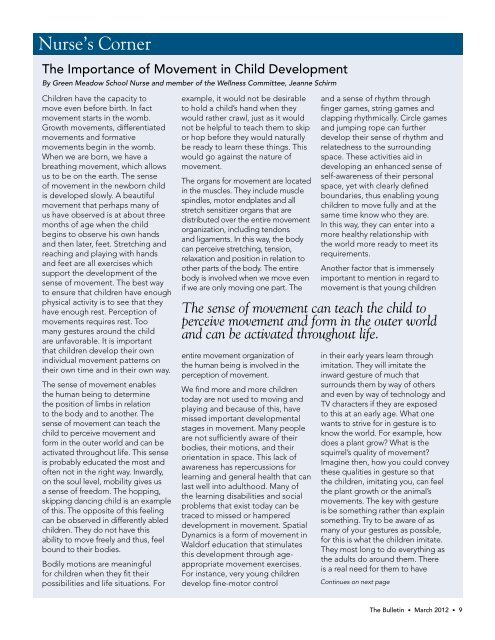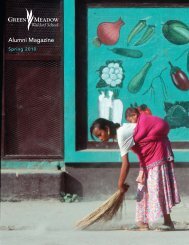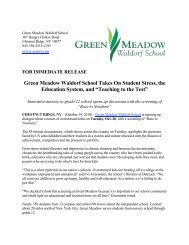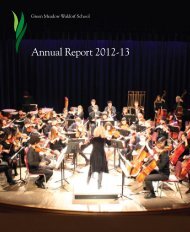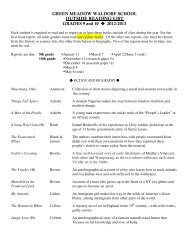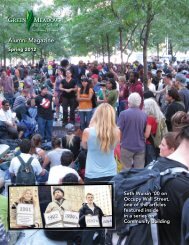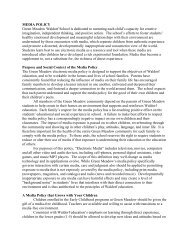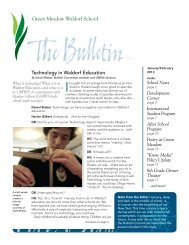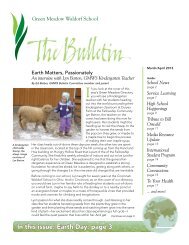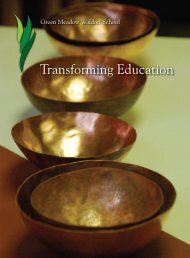March 2012 - Green Meadow Waldorf School
March 2012 - Green Meadow Waldorf School
March 2012 - Green Meadow Waldorf School
You also want an ePaper? Increase the reach of your titles
YUMPU automatically turns print PDFs into web optimized ePapers that Google loves.
Nurse’s Corner<br />
The Importance of Movement in Child Development<br />
By <strong>Green</strong> <strong>Meadow</strong> <strong>School</strong> Nurse and member of the Wellness Committee, Jeanne Schirm<br />
Children have the capacity to<br />
move even before birth. In fact<br />
movement starts in the womb.<br />
Growth movements, differentiated<br />
movements and formative<br />
movements begin in the womb.<br />
When we are born, we have a<br />
breathing movement, which allows<br />
us to be on the earth. The sense<br />
of movement in the newborn child<br />
is developed slowly. A beautiful<br />
movement that perhaps many of<br />
us have observed is at about three<br />
months of age when the child<br />
begins to observe his own hands<br />
and then later, feet. Stretching and<br />
reaching and playing with hands<br />
and feet are all exercises which<br />
support the development of the<br />
sense of movement. The best way<br />
to ensure that children have enough<br />
physical activity is to see that they<br />
have enough rest. Perception of<br />
movements requires rest. Too<br />
many gestures around the child<br />
are unfavorable. It is important<br />
that children develop their own<br />
individual movement patterns on<br />
their own time and in their own way.<br />
The sense of movement enables<br />
the human being to determine<br />
the position of limbs in relation<br />
to the body and to another. The<br />
sense of movement can teach the<br />
child to perceive movement and<br />
form in the outer world and can be<br />
activated throughout life. This sense<br />
is probably educated the most and<br />
often not in the right way. Inwardly,<br />
on the soul level, mobility gives us<br />
a sense of freedom. The hopping,<br />
skipping dancing child is an example<br />
of this. The opposite of this feeling<br />
can be observed in differently abled<br />
children. They do not have this<br />
ability to move freely and thus, feel<br />
bound to their bodies.<br />
Bodily motions are meaningful<br />
for children when they fit their<br />
possibilities and life situations. For<br />
example, it would not be desirable<br />
to hold a child’s hand when they<br />
would rather crawl, just as it would<br />
not be helpful to teach them to skip<br />
or hop before they would naturally<br />
be ready to learn these things. This<br />
would go against the nature of<br />
movement.<br />
The organs for movement are located<br />
in the muscles. They include muscle<br />
spindles, motor endplates and all<br />
stretch sensitizer organs that are<br />
distributed over the entire movement<br />
organization, including tendons<br />
and ligaments. In this way, the body<br />
can perceive stretching, tension,<br />
relaxation and position in relation to<br />
other parts of the body. The entire<br />
body is involved when we move even<br />
if we are only moving one part. The<br />
entire movement organization of<br />
the human being is involved in the<br />
perception of movement.<br />
We find more and more children<br />
today are not used to moving and<br />
playing and because of this, have<br />
missed important developmental<br />
stages in movement. Many people<br />
are not sufficiently aware of their<br />
bodies, their motions, and their<br />
orientation in space. This lack of<br />
awareness has repercussions for<br />
learning and general health that can<br />
last well into adulthood. Many of<br />
the learning disabilities and social<br />
problems that exist today can be<br />
traced to missed or hampered<br />
development in movement. Spatial<br />
Dynamics is a form of movement in<br />
<strong>Waldorf</strong> education that stimulates<br />
this development through ageappropriate<br />
movement exercises.<br />
For instance, very young children<br />
develop fine-motor control<br />
and a sense of rhythm through<br />
finger games, string games and<br />
clapping rhythmically. Circle games<br />
and jumping rope can further<br />
develop their sense of rhythm and<br />
relatedness to the surrounding<br />
space. These activities aid in<br />
developing an enhanced sense of<br />
self-awareness of their personal<br />
space, yet with clearly defined<br />
boundaries, thus enabling young<br />
children to move fully and at the<br />
same time know who they are.<br />
In this way, they can enter into a<br />
more healthy relationship with<br />
the world more ready to meet its<br />
requirements.<br />
Another factor that is immensely<br />
important to mention in regard to<br />
movement is that young children<br />
The sense of movement can teach the child to<br />
perceive movement and form in the outer world<br />
and can be activated throughout life.<br />
in their early years learn through<br />
imitation. They will imitate the<br />
inward gesture of much that<br />
surrounds them by way of others<br />
and even by way of technology and<br />
TV characters if they are exposed<br />
to this at an early age. What one<br />
wants to strive for in gesture is to<br />
know the world. For example, how<br />
does a plant grow What is the<br />
squirrel’s quality of movement<br />
Imagine then, how you could convey<br />
these qualities in gesture so that<br />
the children, imitating you, can feel<br />
the plant growth or the animal’s<br />
movements. The key with gesture<br />
is be something rather than explain<br />
something. Try to be aware of as<br />
many of your gestures as possible,<br />
for this is what the children imitate.<br />
They most long to do everything as<br />
the adults do around them. There<br />
is a real need for them to have<br />
Continues on next page<br />
The Bulletin • <strong>March</strong> <strong>2012</strong> • 9


